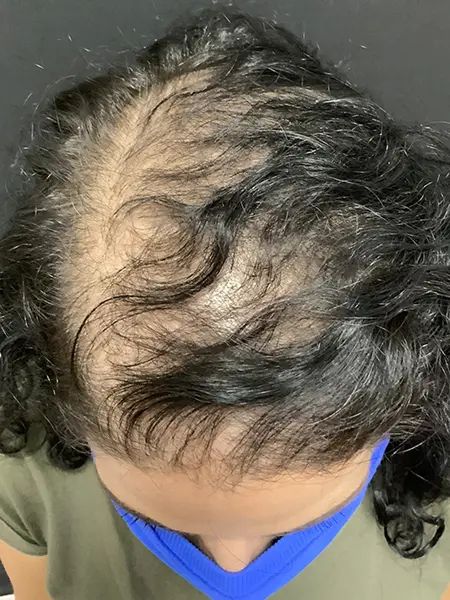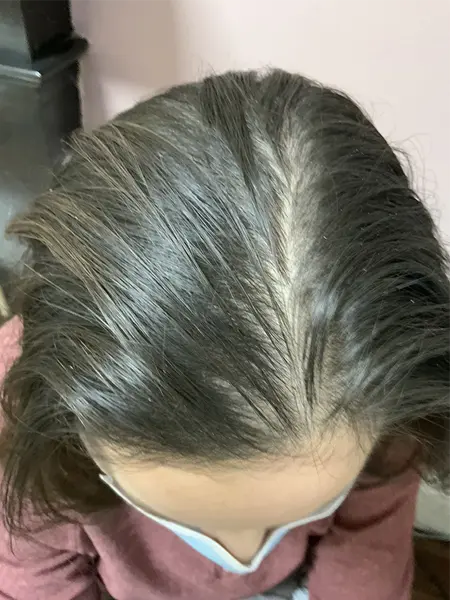Hair loss is such an emotive subject. When I chat to people about thinning hair it soon becomes clear what a huge impact it is having on their self-esteem. And it’s completely understandable. After all, your hair is supposed to be your ‘crowning glory’.
There are now several non-surgical solutions to reduce hair loss which include Platelet-Rich Plasma (PRP), Polynucleotides and Exosomes. In this article I'm going to explain more about the PRP solution.
Who Can Hair Loss Treatments Help?
It's normal to lose around 50-100 hairs per day. This sounds a lot, but considering you have more than 100,000 hairs on your head, this is actually just a tiny fraction.
You may find you lose more depending on what’s going on in your life – stress, illness, weight loss and iron deficiency, for example, can all cause you to shed more hair than usual. This loss is usually only temporary. But early intervention during prolonged periods and help permanent damage.
Genetic and hormonal hair loss
Sadly, it’s a fact of life that a large proportion of you will experience hair loss to some degree as you age. According to the International Journal of Women’s Dermatology, “Androgenetic alopecia (AGA) is a common hair loss disorder caused by genetic and hormonal factors that are characterized by androgen-related progressive thinning of scalp hair in a defined pattern. By the age of 60 years, 45% of men and 35% of women develop AGA”. (Ref 1)
Male pattern hair loss (MPHL) and female pattern hair loss (FPHL) present quite differently. Whereas MPHL usually begins with a receding frontal hairline and progresses to a bald patch on the crown of the head, FPHL can usually be seen as thinning hair on the scalp due to increased hair shedding or a reduction in hair volume, or both.
Who is PRP suitable for?
- Early to moderate male or female pattern hair loss.
- Post-partum or stress-related shedding once triggers are stabilised.
- As maintenance after hair transplant.
What is PRP and How Can it Help?
PRP (Platelet-Rich Plasma) is a non-surgical treatment that uses a concentrated portion of your own blood (the platelets) to encourage the growth and health of existing hair follicles, making your hair appear fuller and healthier.
The best part is that PRP is a completely natural way to stimulate hair growth because it comes from YOU! Which means it has a very low risk of complications.
When might PRP not be the best option?
If your recent bloods show a lower platelet count, PRP may not deliver the growth-factor “boost” we’re aiming for. In that case, I'll discuss alternatives that don’t rely on your own platelets, such as polynucleotides or exosomes. These options can be a better match when platelet yield is limited, and I’ll help you weigh benefits, safety, and cost.
What Happens in a PRP Treatment?
We take a small blood sample from your arm and spin it in a centrifuge to concentrate the platelets. After we numb the area, the platelet-rich plasma is injected across thinning areas of your scalp to support and stimulate the hair follicles.
After treatment, your scalp may look red and feel a bit tender, with tiny pin-pricks of bleeding. This usually settles within 48 hours. You must not wash your hair until the next day, and hair styling products for the first 48 hours.
Watch me doing a PRP treatment using a special device to inject the PRP to the correct depth whilst minimising discomfort.
Realistic PRP Expectations
PRP is not a quick fix and it won’t replace follicles that are completely dormant. It can slow loss and enhance hair quality when used consistently and early - often alongside other measures such as nutrition optimisation, lifestyle choices and scalp care.
It works with the natural growth cycle of your hair follicles, so we recommend that new patients repeat treatments every 4-6 weeks. Most patients need 3 treatments to reduce hair loss and 6 treatments to encourage hair growth, with optimum results seen 6 months after the last treatment.
PRP Before and After Photos
Below are genuine before and after images following a full PRP course at the clinic for a woman with 6-7 months in between. Results will vary with individuals.


Discover if PRP is Right for You
Find out more about unlocking the power of your plasma to reduce hair loss and how exosomes or polynucleotides might be alternative treatments if using your own blood is not appropriate by booking a consultation with me at the clinic.
Author's experience:
Elspeth has worked in nursing and patient care for over six years. This experience has given her a sound understanding of how big an impact hair loss can have on an individual, and what a positive difference an effective treatment can make to people’s lives.
Reference links:
- Ref 1: International Journal of Women's Dermatology, Platelet-Rich Plasma for Androgenetic Alopecia: A Review of the Literature and Proposed Treatment Protocol, J. Stevens and S. Khetarpal, 2018
- Ref 2: DermNetNZ, Female Pattern Hair Loss, Dr Leona Yip, 2007
- Ref 3: Look et Medecine, Platelet Rich Plasma (PRP), Adjuvant Treatment of Alopecia, Pr Barbara Hersant


